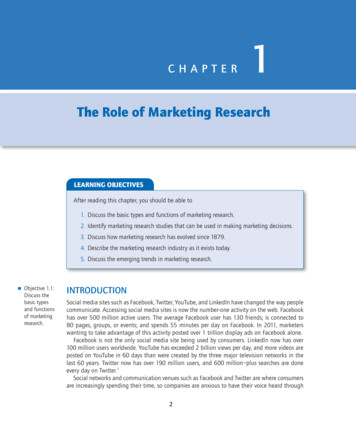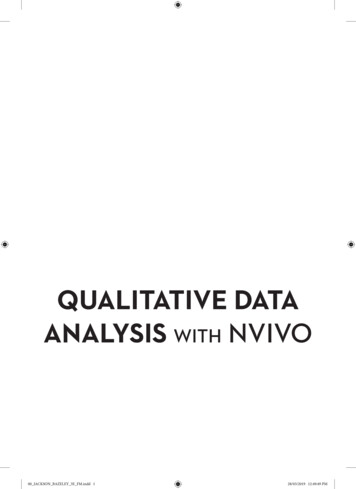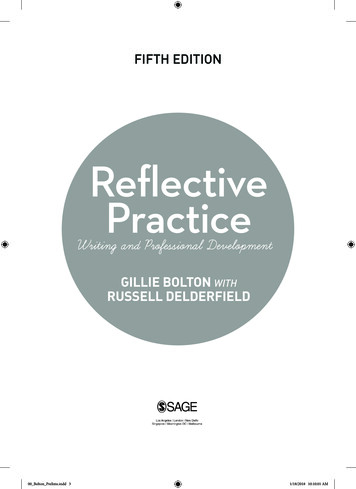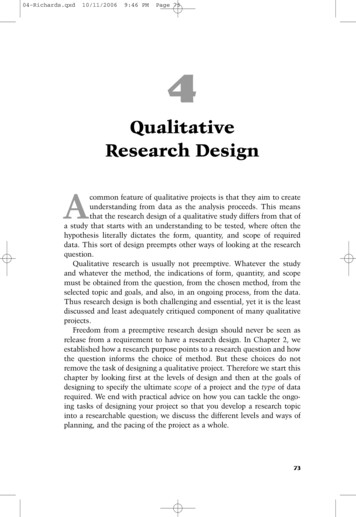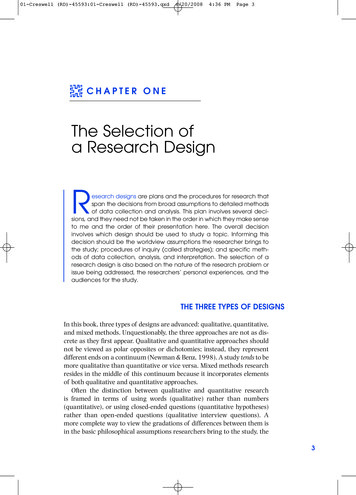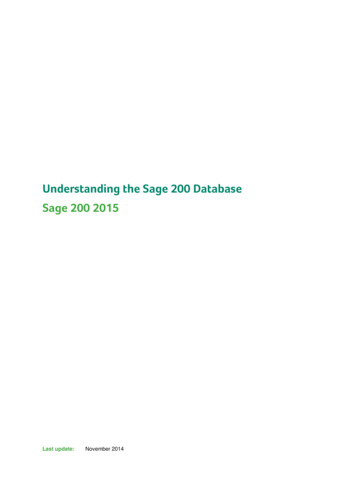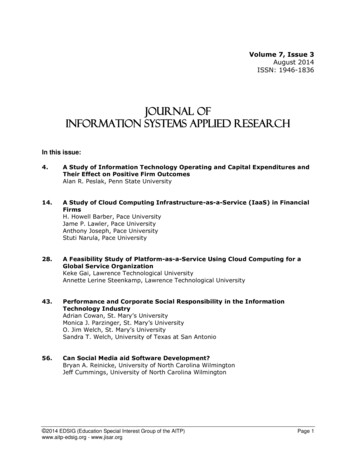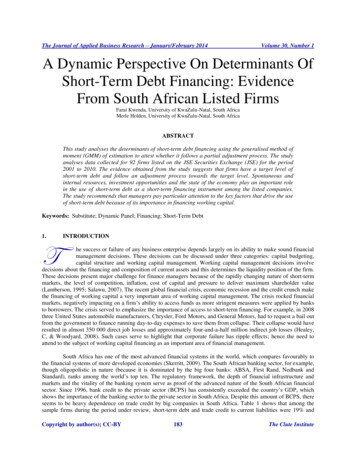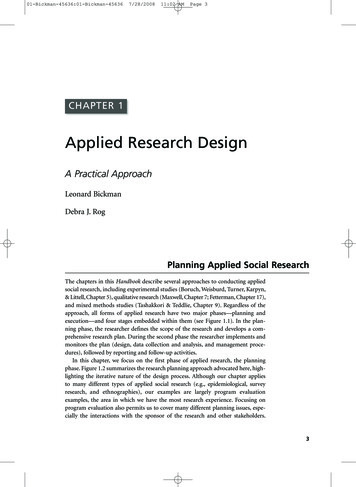
Transcription
01-Bickman-45636:01-Bickman-456367/28/200811:02 AMPage 3CHAPTER 1Applied Research DesignA Practical ApproachLeonard BickmanDebra J. RogPlanning Applied Social ResearchThe chapters in this Handbook describe several approaches to conducting appliedsocial research, including experimental studies (Boruch, Weisburd, Turner, Karpyn,& Littell, Chapter 5), qualitative research (Maxwell, Chapter 7; Fetterman, Chapter 17),and mixed methods studies (Tashakkori & Teddlie, Chapter 9). Regardless of theapproach, all forms of applied research have two major phases—planning andexecution—and four stages embedded within them (see Figure 1.1). In the planning phase, the researcher defines the scope of the research and develops a comprehensive research plan. During the second phase the researcher implements andmonitors the plan (design, data collection and analysis, and management procedures), followed by reporting and follow-up activities.In this chapter, we focus on the first phase of applied research, the planningphase. Figure 1.2 summarizes the research planning approach advocated here, highlighting the iterative nature of the design process. Although our chapter appliesto many different types of applied social research (e.g., epidemiological, surveyresearch, and ethnographies), our examples are largely program evaluationexamples, the area in which we have the most research experience. Focusing onprogram evaluation also permits us to cover many different planning issues, especially the interactions with the sponsor of the research and other stakeholders.3
01-Bickman-45636:01-Bickman-4563647/28/200811:02 AMPage 4APPROACHES TO APPLIED RESEARCHPlanningStage IDefinitionFigure 1.1ExecutionStage IIDesign/planStage IIIImplementationStage IVReporting/follow-upThe Conduct of Applied ResearchOther types of applied research need to consider the interests and needs of theresearch sponsor, but no other area has the variety of participants (e.g., programstaff, beneficiaries, and community stakeholders) involved in the planning stage likeprogram evaluation.Stage I of the research process starts with the researcher’s development of anunderstanding of the relevant problem or societal issue. This process involves working with stakeholders to refine and revise study questions to make sure thatthe questions can be addressed given the research conditions (e.g., time frame,resources, and context) and can provide useful information. After developing potentially researchable questions, the investigator then moves to Stage II—developing theresearch design and plan. This phase involves several decisions and assessments,including selecting a design and proposed data collection strategies.As noted, the researcher needs to determine the resources necessary to conductthe study, both in the consideration of which questions are researchable as well asin making design and data collection decisions. This is an area where social scienceacademic education and experience is most often deficient and is one reason whyacademically oriented researchers may at times fail to deliver research products ontime and on budget.Assessing the feasibility of conducting the study within the requisite time frameand with available resources involves analyzing a series of trade-offs in the type ofdesign that can be employed, the data collection methods that can be implemented,the size and nature of the sample that can be considered, and other planning decisions. The researcher should discuss the full plan and analysis of any necessarytrade-offs with the research client or sponsor, and agreement should be reached onits appropriateness.As Figure 1.2 illustrates, the planning activities in Stage II often occur simultaneously, until a final research plan is developed. At any point in the Stage II process,the researcher may find it necessary to revisit and revise earlier decisions, perhapseven finding it necessary to return to Stage I and renegotiate the study questions ortimeline with the research client or funder. In fact, the researcher may find that thedesign that has been developed does not, or cannot, answer the original questions.The researcher needs to review and correct this discrepancy before moving on toStage III, either revising the questions to bring them in line with what can be done
01-Bickman-45636:01-Bickman-456367/28/200811:02 AMPage 5Applied Research DesignStage IResearchDefinitionUnderstand the problemIdentify questionsRefine/revise questionsStage IIResearchDesign/planChoose design/datacollection ess feasibilityTo executionFigure 1.2Applied Research Planningwith the design that has been developed or reconsidering the design trade-offs thatwere made and whether they can be revised to be in line with the questions of interest. At times, this may mean increasing the resources available, changing the sample being considered, and other decisions that can increase the plausibility of thedesign to address the questions of interest.Depending on the type of applied research effort, these decisions can eitherbe made in tandem with a client or by the research investigator alone. Clearly,involving stakeholders in the process can lengthen the planning process and atsome point, may not yield the optimal design from a research perspective. Theretypically needs to be a balance in determining who needs to be consulted, forwhat decisions, and when in the process. As described later in the chapter, theresearcher needs to have a clear plan and rationale for involving stakeholders in5
01-Bickman-45636:01-Bickman-4563667/28/200811:02 AMPage 6APPROACHES TO APPLIED RESEARCHvarious decisions. Strategies such as concept mapping (Kane & Trochim, Chapter 14)provide a structured mechanism for obtaining input that can help in designing astudy. For some research efforts, such as program evaluation, collaboration, andconsultation with key stakeholders can help improve the feasibility of a study andmay be important to improving the usefulness of the information (Rog, 1985).For other research situations, however, there may be need for minimal involvement of others to conduct an appropriate study. For example, if access or “buy in”is highly dependent on some of the stakeholders, then including them in all majordecisions may be wise. However, technical issues, such as which statistical techniques to use, generally do not benefit from, or need stakeholder involvement. Inaddition, there may be situations in which the science collides with the preferences of a stakeholder. For example, a stakeholder may want to do the researchquicker or with fewer participants. In cases such as these, it is critical for theresearcher to provide persuasive information about the possible trade-offs of following the stakeholder advice, such as reducing the ability to find an effect if oneis actually present—that is, lowering statistical power. Applied researchers oftenfind themselves educating stakeholders about the possible trade-offs that couldbe made. The researcher will sometimes need to persuade stakeholders to thinkabout the problem in a new way or demonstrate the difficulties in implementingthe original design.The culmination of Stage II is a comprehensively planned applied research project, ready for full-scale implementation. With sufficient planning completed at thispoint, the odds of a successful study are significantly improved, but far from guaranteed. As discussed later in this chapter, conducting pilot and feasibility studiescontinues to increase the odds that a study can be successfully mounted.In the sections to follow, we outline the key activities that need to be conductedin Stage I of the planning process, followed by highlighting the key features thatneed to be considered in choosing a design (Stage II), and the variety of designsavailable for different applied research situations. We then go into greater depthon various aspects of the design process, including selecting the data collectionmethods and approach, determining the resources needed, and assessing theresearch focus.Developing a Consensus onthe Nature of the Research ProblemBefore an applied research study can even begin to be designed, there has to bea clear and comprehensive understanding of the nature of the problem beingaddressed. For example, if the study is focused on evaluating a program for homeless families being conducted in Georgia, the researcher should know what researchand other available information has been developed about the needs and characteristics of homeless families in general and specifically in Georgia; what evidencebase exists, if any for the type of program being tested in this study; and so forth.In addition, if the study is being requested by an outside sponsor, it is important tohave an understanding of the impetus of the study and what information is desiredto inform decision making.
01-Bickman-45636:01-Bickman-456367/28/200811:02 AMPage 7Applied Research DesignStrategies that can be used in gathering the needed information include thefollowing: review relevant literature (research articles and reports, transcripts of legislative hearings, program descriptions, administrative reports, agency statistics,media articles, and policy/position papers by all major interested parties); gather current information from experts on the issue (all sides and perspectives) and major interested parties; conduct information-gathering visits and observations to obtain a real-worldsense of the context and to talk with persons actively involved in the issue; initiate discussions with the research clients or sponsors (legislative members;foundation, business, organization, or agency personnel; and so on) to obtainthe clearest possible picture of their concerns; and if it is a program evaluation, informally visit the program and talk with thestaff, clients, and others who may be able to provide information on theprogram and/or overall research context.Developing the Conceptual FrameworkEvery study, whether explicitly or implicitly, is based on a conceptual frameworkor model that specifies the variables of interest and the expected relationshipsbetween them. In some studies, social and behavioral science theory may serve asthe basis for the conceptual framework. For example, social psychological theoriessuch as cognitive dissonance may guide investigations of behavior change. Otherstudies, such as program and policy evaluations, may be based not on formal academic theory but on statements of expectations of how policies or programs arepurported to work. Bickman (1987, 1990) and others (e.g., Chen, 1990) have written extensively about the need for and usefulness of program theory to guide evaluations. The framework may be relatively straightforward or it may be complex, asin the case of evaluations of comprehensive community reforms, for example, thatare concerned with multiple effects and have a variety of competing explanationsfor the effects (e.g., Rog & Knickman, 2004).In evaluation research, logic models have increased in popularity as a mechanism for outlining and refining the focus of a study (Frechtling, 2007; McLaughlin& Jordan, 2004; Rog, 1994; Rog & Huebner, 1992; Yin, Chapter 8, this volume). Alogic model, as the name implies, displays the underlying logic of the program (i.e.,how the program goals, resources, activities, and outcomes link together). In several instances, a program is designed without explicit attention to the evidence baseavailable on the topic and/or without explicit attention to what immediate andintermediate outcomes each program component and activity needs to accomplishto ultimately reach the desired longer-term outcomes. The model helps displaythese gaps in logic and provides a guide for either refining the program and/or outlining more of the expectations for the program. For example, community coalitions funded to prevent community violence need to have an explicit logic thatdetails the activities they are intended to conduct that should lead to a set of outcomes that chain logically to the prevention of violence.7
01-Bickman-45636:01-Bickman-4563687/28/200811:02 AMPage 8APPROACHES TO APPLIED RESEARCHThe use of logic modeling in program evaluation is an outgrowth of the evaluability assessment work of Wholey and others (e.g., Wholey, 2004), which advocatesdescribing and displaying the underlying theory of a program as it is designed andimplemented prior to conducting a study of its outcomes. Evaluators have sincediscovered the usefulness of logic models in assisting program developers in theprogram design phase, guiding the evaluation of a program’s effectiveness, andcommunicating the nature of a program as well as changes in its structure over timeto a variety of audiences. A program logic model is dynamic and changes not onlyas the program matures but also may change as the researcher learns more aboutthe program. In addition, a researcher may develop different levels of models fordifferent purposes; for example, a global model may be useful for communicatingto outside audiences about the nature and flow of a program, but a detailed modelmay be needed to help guide the measurement phase of a study.In the design phase of a study (Stage II), the logic model will become importantin guiding both the measurement and analysis of a study. For these tasks, the logicmodel needs to not only display the main features of a program and its outcomesbut also the variables that are believed to mediate the outcomes as well as those thatcould moderate an intervention’s impact (Baron & Kenny, 1986). Mediating variables, often referred to as intervening or process variables, are those variablesthrough which an independent variable (or program variable) influences an outcome. For example, the underlying theory of a therapeutic program designed toimprove the overall well-being of families may indicate that the effect of theprogram is mediated by the therapeutic
monitors the plan (design, data collection and analysis, and management proce - dures), followed by reporting and follow-up activities. In this chapter, we focus


